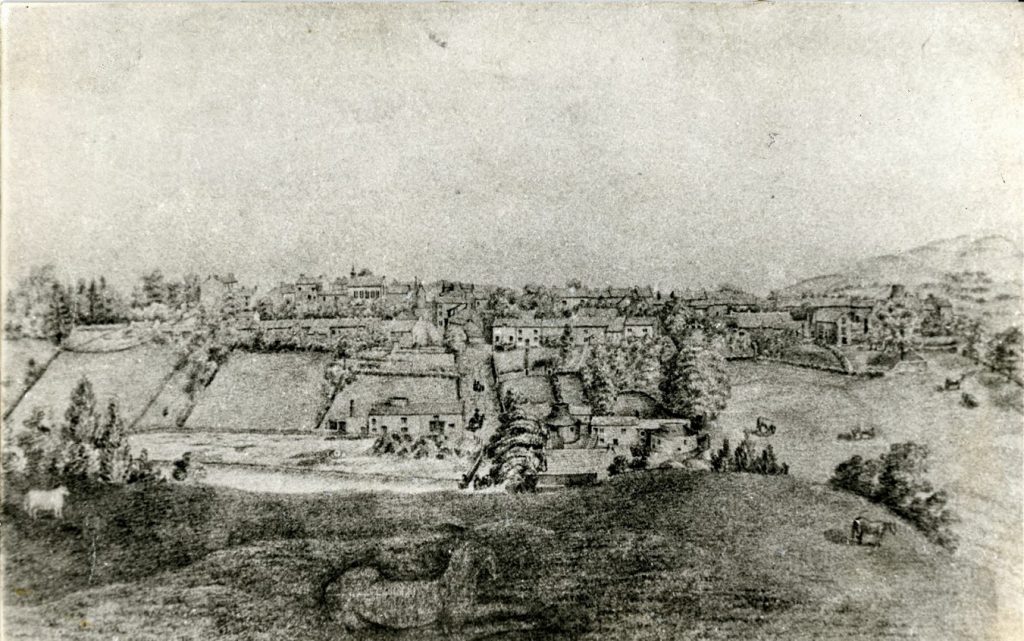The bottle kiln of Town End Pottery can be seen on the top right hand side of this drawing of Burton-in-Lonsdale (on the way out towards Ingleton). It is the only image of Town End Pottery I have ever seen, which is surprising, considering the pottery was still in business up to the First World War. Somebody out there must have some photos?

Town End pottery was an old established pottery in the village that can be traced back to the 1700’s. At the turn of the last century, it was run by John “Jacky” Parker. Jacky had inherited the business from his father William Parker who had bought the pottery in 1863. Jacky was a hardworking man and a good thrower. He produced traditional country wares all in terracotta (or “black ware” as the Burton potters called it) and sold his pots locally. He would have made such things as jugs, jars, bowls, butter pots, plant pots and basically any pot that was demanded by households or farms. The pots probably had a simple slip decoration. The clay would have all been taken from Mill Hill Close to Greta House.
The main throwers were Jacky and Freddie Slater. Freddie learnt how to throw at Town End Pottery and became one of the best throwers to emerge from Burton. Tom Park, a blind man was employed as a wheel turner, which would basically involve sitting on a seat and turning a hand crank to power a pottery wheel. George Kilshaw, Tom Skeates and Bill or John Saul were employed as general workers. Jacky’s son Jim Parker also worked at the pottery as a youngster, but to the disappointment of Jacky showed no interest in being a potter and got out of the business as soon as he could.
Jacky used a red lead glaze on his pots. He was very fond of chewing tobacco and is remembered glazing his pots with red lead covering his hands and waistcoat then dipping his red hands into his waist coat to grab some tobacco to chew. Nobody knew the dangers of eating raw lead at this time!
Town End Pottery had a shop where wares were on sale, so people could call in and buy and order pots. However Jacky’s main business was selling pots in Kendal, which was a regular trip. I’m guessing that he probably had a market stall in Kendal and possibly supplied some shops? He kept two horses both called Bob and a large cart for taking the pots to Kendal. Jim Brennand was one of a few people that would take the horse and cart up to Kendal. The fully laden cart would set of the night before and stay overnight at Aynams, which allowed the horses some rest before making the return journey the next day.
Sadly Jacky died at the age of 60 and on his 60th birthday in 1908. It is thought that he died of lead poisoning.
Freddie Slater borrowed money and bought the business. However despite Freddie being a brilliant thrower, he wasn’t great at business. According to Richard Bateson, He was “too busy advising other people how to run their businesses, instead of running his own”. Freddie only lasted 3 or 4 years before going bankrupt just before the First World War. Freddie then moved out of Burton and got a job at Portobello Pottery in Edinburgh, where he discovered lots of new pottery techniques, trade unions and health & safety regulations all of which he brought back to Burton-in Lonsdale when he eventually returned, causing all sorts of disruption within the Burton potteries, but that, as they say is, a story for another day.
Unlike the other potteries in Burton at this time, Town End Pottery did not produce stoneware bottles. This could have been because they had no access to digging the stoneware clay, or it could be that they had simply found a good market for the country wares that they produced?
I’ve often wondered whether if Jacky’s son Jim had shown more interest in the business, the pottery would have continued for longer. After all Wetheriggs Pottery, a family run pottery near Penrith produced similar wares to Town End Pottery and managed to keep going until 2008. The truth is pottery is a very fickle business and it requires at least one dedicated person willing to work long hours for sometimes little remuneration. It’s often easier to find other work. Interestingly, Jim Parker’s son, John Willy Parker ended up working at Waterside Pottery (after the war), so it would appear that the pottery gene seems to have skipped a generation. Jacky had daughters, who I guess could have continued the business, however, unfortunately, pottery in Burton was seen as an exclusively male activity. I have never heard of any women potters in Burton, although Richard Bateson’s sister and sister-in-law, Mable and Millie, did work briefly at Waterside Pottery during the First World War when the pottery lost a lot of its men to the war effort. Richard can remember being “rather horrified to think of women in the pottery” when he found out whilst he was in the army. Richard was concerned not just about the dirty conditions in the pottery, but also the foul language used by the potters. Stoke –on-Trent on the other hand employed thousands of women in the potteries, especially for painting and decorating pots. I feel not using women in the potteries of Burton was possibly a mistake, as from my own experience of selling pottery, it is usually the woman that chooses the pot, therefore it surely makes sense for them to be involved in the making and design process?
Town End Pottery was sadly demolished by the council in 1923 in order to widen the road. Did I mention I have no photos of it?
